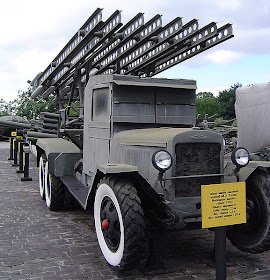
http://dropshiphorizon.blogspot.com/





The Katyusha was originally a World War II-era Soviet rocket. During the Great Patriotic War the BM-8 and BM-13 rocket launchers [some times confusingly called rocket mortars] got their famous name "Katyusha". In March 1941 the first successful fire tests of BM-13 rocket launchers were carried out and 21 June mass production order was sign. Originally this system was based on standard ZIS-5 but this experience wasn't successful. Afterwards ZIS-6 was chosen. At last the BM-13 was mounted only on Studebaker-US6 (BM-13N). The BM-13 could fire 16 130mm rockets simultaneously.
The Katyusha, or Little Kate, was a rocket launcher mounted on a heavy truck that fired volleys of up to 48 rockets nearly four miles. The Katyusha was infamous among German troopers who quickly learned to dread its distinctive scream. They named the Katyusha “Stalin’s Organ.” Soviet guards mortar units were equipped with multiple rocket launchers, the famous katyushas, named after the title of a popular song of the time. Some military scholars credit the Katyusha for the relief of Stalingrad.
The word Katyusha is the tender diminutive of the female name Ekatherina (Katherine). For example, the diminutive for Natalia is Natasha, and the tender diminutive for Natasha is Natashenka. In the case of Ekaterina, Katya is the nickname and Katyusha, a tender diminutive. Katyusha is a Soviet song about a girl longing for her beloved, who is away on military service. The music was composed in 1938 by Matvei Blanter and the lyrics were written by Mikhail Isakovsky.


In the battle for Berlin, a large city converted by the Germans into a fortress for a last ditch stand, the Russians used massed mechanized units in street battles. However, Soviets do not recommend that tank units be sent into the city, where movement is usually restricted and channelized, barricades and obstacles easily prepared, and every building becomes a potential strongpoint and direct-fire gun emplacement, but the lessons learned during the battle of Berlin are worthy of attention.




Throughout history military planners have viewed cities as centers of gravity and sources of national strength. Cities are population centers; transportation and communication hubs; key sites of industrial, financial, and information systems; seats of government; and repositories of wealth. Because the US has worldwide interests that directly relate to global security, deployments into urban environments are likely to become more frequent. The SBCT infantry platoon and squad are uniquely equipped and manned to deal with the wide range of tactical situations that are normally found in the conduct of urban operations. The primary role of the SBCT platoon and squad within these urban operations is to close with and destroy enemy forces through the use of overwhelming fire and precision movement. This chapter describes techniques, procedures, and special considerations that platoons and squads will use throughout the planning and execution of operations in an urban environment.
http://www.globalsecurity.org/military/library/policy/army/fm/3-21-9/chap6.htm

North Carolina coast (Dec. 5, 2006) - Sailors assigned to Riverine Squadron One (RIVRON-1) prepare for their final exercise and evaluations near Camp Lejeune, N.C. Sailors from RIVRON-1 are preparing for deployment in support of Maritime Security Operations and the global war on terrorism.
http://www.strategypage.com/military_photos/military_photos_200612202241.aspx
